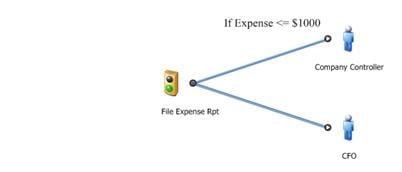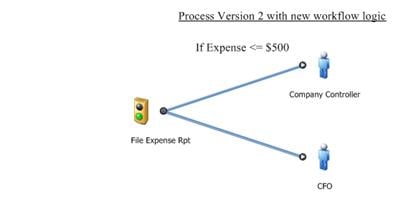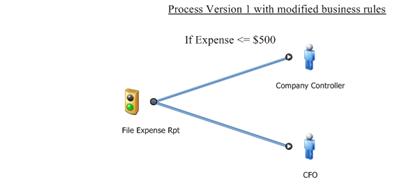With the focus of every company on finances, especially corporate expenses, the end of a financial quarter can be interesting. All the way from personal finances to corporate finances, "belt tightening" tends to occur for some period of time. When a company has situational changes in their day-to-day business, these changes affect the underlying established business processes in place. When these decisions are made quickly changes to the underlying business processes can be both time consuming and laborious. Further, as the end of month comes and goes, time also has to be spent to reinstate the original process design (representing two distinct efforts of changing the business process design).
Consider a simplified portion of an Expense Reporting process. In this process, if the expense report is less than or equal to $1000, then it is to be reviewed by the Company Controller. If it is greater than $1000, then the expense is to be reviewed by the CFO.

Now consider that the end of the month is here, and the CFO wishes to review all expenses greater than $500. In the most rudimentary form of business process design, the business rules (routing business logic) are part of the integral business process design. In this case, if there is a change to be made to the routing logic, then the business process designer would have to eidt the core process, make changes, and republish the modified process to the live BPM Server. Moreover, without sophisticated change management features, live running instances of the business process cannot be affected.

A stronger business process architecture can be created if the business rules are extrapolated from the business process itself. Without disrupting the core business process design, the business process designer can make the necessary situational rules changes. For example, if the CFO wanted to see all expense reports greater than $500, the business process designer could change just the business process rule (and not have to necessarily edit the business process design itself).

But, consider the following possible two situations- business changes are needed once again when:
- further "belt tightening" is desired by the CFO, or
- the business process owner, (the person who can actually make the business process design changes), is not available
The ideal result in this case, is by providing a simple and straight-forward way for the CFO to make changes to the business process WITHOUT changing the core business process design or the business process rules. Ultimus iBAM provides the ability for the CFO to make changes through secure desktop "gauges" or "switches" (see the below picture) to customize how the business process routing logic is working. Take for example the following Ultimus iBAM gauges:

By utilizing the dial gauge on the right, the CFO can change the expense report threshold review level independent of the business process core design. With each new expense report filed, Ultimus BPM Server will check the gauge threshold setting, and utilize its setting when executing the business process rule on the "File Expense Report" complete event. The CFO now has the availability to restrict or loosen the control on the Expense Report Review process on demand. Moreover, the business process designer no longer has to be involved with every change, and once the end of the quarter comes and goes, the CFO can reinstate the original expense report threshold level.
As you can see in the various situations discussed, process optimization comes in different forms. Sometimes, process optimization needs are clear and distinct. But often enough, processes need to be optimized and changed temporarily and the life of those process optimization changes is finite. Rather than continually having a process designer on call to make temporary and situational business process changes, it makes sense to enable the key process champions to make those changes in response to the changing business needs.
So, I leave you with the question: Where is your current process struggling due to a recent structural change?
Chris Adams
VP Product Marketing and Management
Ultimus


